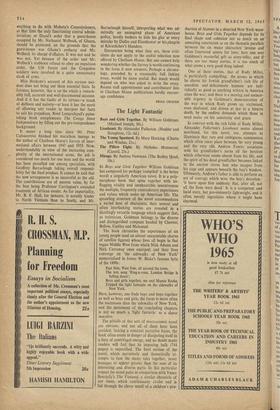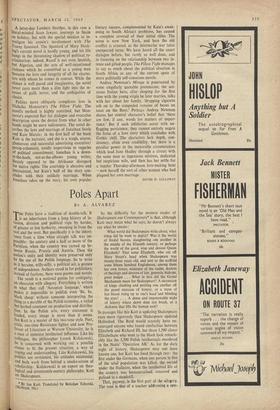The Light Fantastic
Boys and Girls Together. By William Goldman. (Michael Joseph, 30s.) IN Boys and Girls Together William Goldman has composed (or perhaps `compiled' is the better word) a singularly American novel. It is a poly- morphous book that spins together with un- flagging vitality and inexhaustible inventiveness the multiple, frequently contradictory experiences and values which make up American life. The sprawling structure of the novel accommodates a varied host of characters; their several and often interlocking stories are revealed in a dazzlingly versatile language which suggests that, as technician, Goldman belongs to the diverse and distinguished company headed by Cheever, Bellow, Updike and Malamud.
The book chronicles the experiences ot six young people (and an almost uncountable chorus of satellite figures) whose lives all begin in that vague Middle West from which Nick Adams and Nick Carraway once emerged; and their lives converge on `the sidewalks of New York' memorialised in James W. Blake's famous lyric of the 1890s:
East Side, West Side, all around the town, The tots sang `Ring-a-rosie, London Bridge is falling down'; Boys and girls together, me and Mamie Rorke, Tripped the light fantastic on the sidewalks of New York.
Here, however, one finds boys and boys together as well as boys and girls, the focus is more often the mattresses than the sidewalks of New York, and the movement of the concluding chapters is not so much a `light fantastic as a danse macabre.
The pitfalls of this sort of macrocosmic novel are obvious, and not all of them have been avoided; lacking a constant narrative focus, the book often seems in danger of dissipating itself in a fury of centrifugal energy, and no doubt many readers will feel that its imposing bulk (744 pages) is unjustified. The final section of the novel, which narratively and thematically at- tempts to fuse the many talcs together, never manages to appear greater than the sum of its interesting and diverse parts. In this particular respect the novel pales in comparison with Vance Bourjaily's The Violated, a similar chronicle of our times, which continuously circles and is fed through the clever motif of a children's pro- duction of hamlet in a deserted New York ware- house. Boys and Girls Together depends for its final shape and cohesion not so much on an annealing conclusion as on the thematic parallels between the six major characters' intense and often frustrated quests for love; here one sees Goldman's masterful gift as story-teller, and if there are too many stories, it is too much of what seems a very good thing indeed One of these stories, that of Rudy Miller,' is particularly compelling: the scenes in which he shares his Jewish grandfather rich life of anecdote and delicatessen humour are indi- vidually as good as anything written in America since the war; and there is a moving and memor- able urgency in Goldman's demonstration of the way in which Rudy grows up, victimised, even deafened, and driven at last to a bizarre death, by the endless demands which those in need make on his sensitivity and grace.
In contrast with the rich fable of Rudy Miller, Alexander Fullerton's Lionheart seems almost moribund, for this novel, too, attempts to illuminate that rare and ambiguous communion which often takes place between the very young and the very old. Andrew Fowler associates , with his grandfather's yarns all the heroism which otherwise seems absent from his life, and the spirit of his dead grandfather becomes linked to the ancient circus lion who escapes from . his cage and appears beneath the boy's window. • Ultimately, Andrew's father is able to perform an act of courage which wins the boy's devotion : . 'it burst upon him suddenly that, after all, not all the lions were dead.' It is a competent and lucid story, but pre-eminently lightweight, and it often merely ingratiates where it might have charmed.
A latter-day Lambert Strether, in this case a literal-minded Scots lawyer, journeys to Spain en holiday, but with the special mission to in- vestigate his cousin's involvement with The Young Spaniard. The Spaniard of Mary Hock- ing's current novel is hardly young, and his life hangs in the threatening shadovi( of political re- crimination; indeed, Raour is not even Spanish, but Algerian, and the acts of well-intentioned Violence which he committed as a young man threaten the love and integrity of all the charac- ters with whom he comes in contact. While the climax is well paced and imaginative, the novel never casts more than a dim light into the re- cesses of guilt, terror, and the ambiguities of choice.
Politics more obliquely complicate love in Nicholas Monsarrat's The Pillow Fight. The noVel's method is highly contrived, but Mon- sarrat's expected flair for dialogue and evocative description saves the device from what in other hands might be mere tediousness. The novel de- scribes the love and marriage of Jonathan Steele and Kate Marais: in the first half of the book Kate is the narrator, and she is a tough, coarse, glamorous and successful advertising executive/ gossip-columnist, totally impervious to vagaries of Political commitment; Jonathan is a down- at-the-heels, out-at-the-elbows young writer, fiercely opposed to the Afrikaner disregard for native rights. The courtship is abrasive and intermittent, but Kate's half of the story con- cludes with their unlikely marriage. When Jonathan takes up the story, his own popular literary success, complemented by Kate's awak- ening to South Africa's problems, has caused a complete reversal of their initial roles. The scene is now New York, and here the old conflict is aroused, as the internecine war takes unexpected turns. We have heard all the smart dialogue before, but rarely so well done, and in focusing on the relationship between two in- tense and gifted people, The Pillow Fight manages to say as much about the political situation in South Africa as any of the current spate of more politically self-conscious novels.
Andrea Newman's Mirage is punctuated by some singularly quotable pretensions; the sen- suous Italian hero, after sleeping for the first time with the young virgin he later marries, talks with her about her family, 'dropping cigarette ash on to the congealed remains of beans on toast on the floor.' Perhaps Andrea Newman shares her central character's belief that 'there are few, if any, words for matters of impor- tance.' But if such infelicities occur with un- flagging persistence, they cannot entirely negate the force of a love story which concludes with Gothic chill. The characters lack depth, con- sistency, often even credibility, but there is a peculiar power in the inexorable circumstances which lead Jane Hadley through a circuit with the same man as ingenuous mistress, dedicated but suspicious wife, and then has her settle for a regular Thursday-afternoon love-making bout —now herself the sort of other woman who had plagued her own marriage.
DAVID D. GALLOWAY



































 Previous page
Previous page